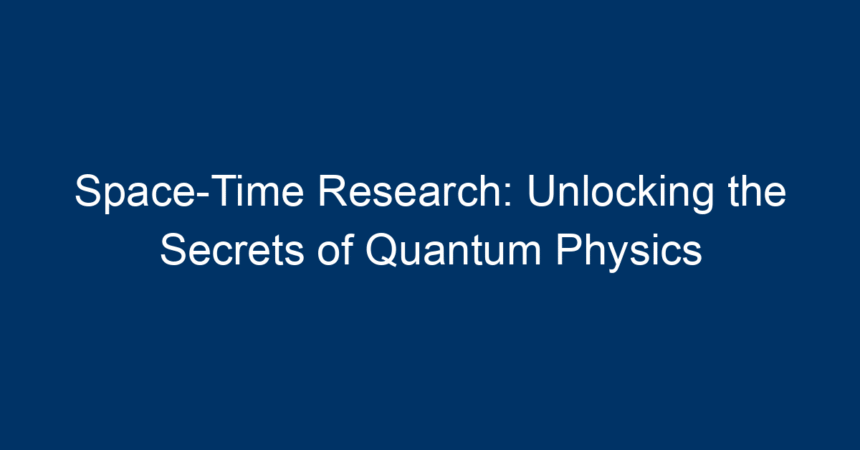Introduction
In the realms of theoretical physics, few concepts are as enigmatic and compelling as space-time—an intricate tapestry woven from the threads of time and the three dimensions of space. This captivating framework is essential for understanding not only our universe at macroscopic scales but also the subatomic world governed by quantum physics. As scientists delve into space-time research, they inch closer to unlocking the mysteries that have puzzled humanity for centuries. This article will explore the significance of space-time research, its implications for quantum physics, and the exciting frontier that lies ahead.
What is Space-Time?
Space-time is a four-dimensional construct that merges the dimensions of space and time into a single continuum. In this framework:
- Three dimensions of space (length, width, depth) are combined with one dimension of time to create a four-dimensional entity.
- This concept fundamentally revolutionized classical physics, shifting our understanding from Newtonian ideas to Einstein’s theory of relativity.
Understanding Einstein’s Theory of Relativity
Albert Einstein introduced the idea of space-time in his theory of relativity, postulating that mass and energy affect the geometry of space-time:
-
Special Relativity: This theory reveals that time can dilate and lengths can contract when objects move at speeds approaching light.
- General Relativity: Here, gravity is depicted not as a force but as the curvature of space-time caused by massive objects. Understanding these effects is crucial for space-time research, providing insights into gravitational waves and black holes.
Quantum Physics and Its Connection to Space-Time
Quantum physics describes the behavior of matter and energy on the smallest scales. It surfaces profound questions regarding reality, locality, and determinism. An integral part of current space-time research involves:
Quantum Entanglement
One of the most bewildering phenomena in quantum physics is entanglement, where particles become interconnected, instantly affecting one another regardless of distance. Space-time research investigates the implications of entanglement:
- Non-Locality: This challenges traditional views of space, suggesting that information can be exchanged faster than light, potentially redefining our understanding of time itself.
- Quantum Communication: Applications include the potential development of secure communication systems leveraging entangled particles.
Quantum Gravity
Bridging the gap between quantum mechanics and general relativity is a pivotal area of space-time research. Scientists are exploring theories that could unify these concepts:
- String Theory: Proposes that fundamental particles are actually tiny vibrating strings, potentially existing in multiple dimensions beyond our observable universe.
- Loop Quantum Gravity: This theory breaks space-time into discrete units, suggesting that space itself has a granular structure at the smallest scale.
Implications of Space-Time Research
Understanding space-time has vast ramifications for multiple fields, transcending theoretical physics to touch upon technology, philosophy, and even cosmology.
Technological Innovations
Space-time research is the backbone of many technological advancements:
- GPS Systems: Utilizing principles of general relativity, GPS satellites must adjust their clocks to account for the time dilation experienced due to their speed and gravitational field.
- Quantum Computing: By harnessing the principles of quantum physics, these computers promise to outperform classical computers, potentially solving problems previously deemed impossible.
Philosophical Considerations
The exploration of space-time pushes the boundaries of philosophy:
- Nature of Reality: Questions arise about the nature of free will, causality, and the interconnectedness of events across time and space.
- Existence: Do concepts like time and space exist independently, or are they merely human constructs?
The Future of Space-Time Research
As we forge ahead, space-time research is poised to unveil groundbreaking insights. Some key focus areas include:
Advancements in Technology
Given the symbiotic relationship between space-time research and technology, future advancements may reshape our world:
- AI and Machine Learning: To process and analyze vast amounts of data related to space-time phenomena, AI can enhance our understanding and drive innovation.
- Experimental Physics: Facilities like CERN and LIGO will continue to observe phenomena that could elucidate space-time’s mysteries.
New Theoretical Frameworks
The quest for a unified theory continues to invigorate physicists worldwide:
- Multiverse Theories: Exploring the possibility of alternate universes will redefine cosmology, opening discussions about infinite realities.
- Experimental Validation: Future experiments could provide critical evidence supporting or refuting existing theories of quantum gravity.
Conclusion
Space-time research serves as a cornerstone in our pursuit of understanding the universe, blending the mysteries of quantum physics with cutting-edge technological innovation. As we embark on this exhilarating journey, it is essential to foster interdisciplinary collaboration among physicists, engineers, and philosophers.
Actionable Insights
- Stay Informed: Regularly follow reputable science journals and institutions to keep abreast of the latest findings in space-time research.
- Engage with Communities: Participate in forums and discussion groups dedicated to physics and cosmology, sharing insights and perspectives.
- Support Education: Encourage educational initiatives focused on science, technology, engineering, and mathematics (STEM) to inspire future generations of explorers.
The journey into the depths of space-time research is just beginning. By remaining curious and engaged, we can contribute to the exploration of our universe’s fundamental truths, unraveling the profound mysteries of quantum physics one discovery at a time.




